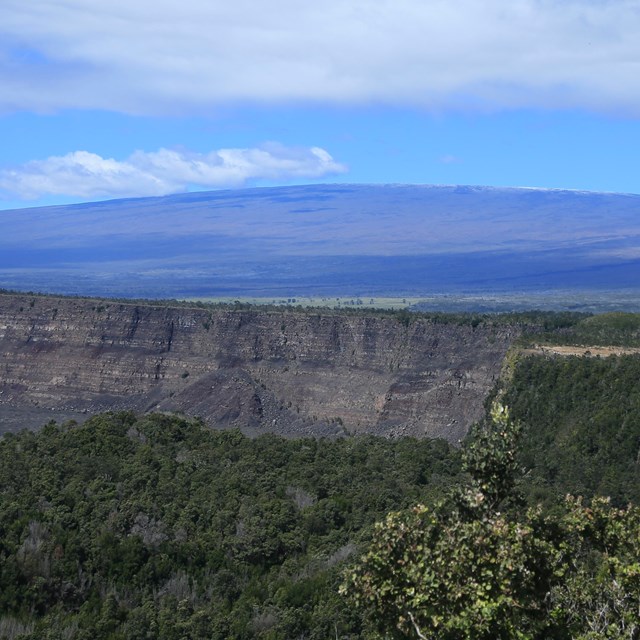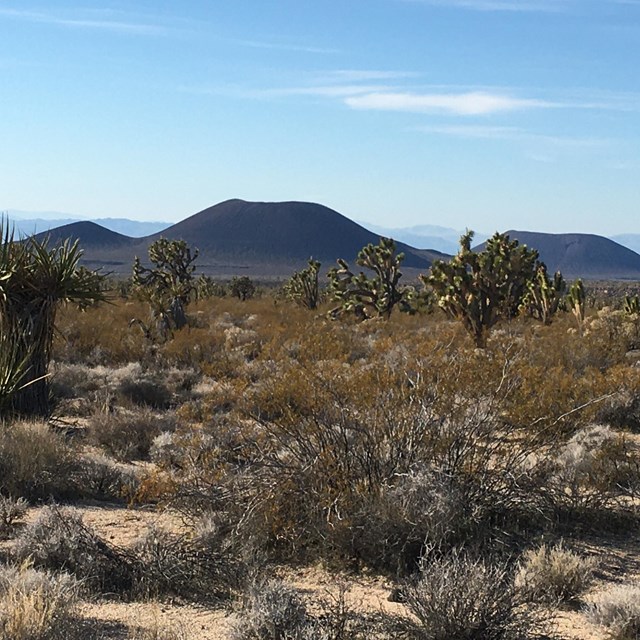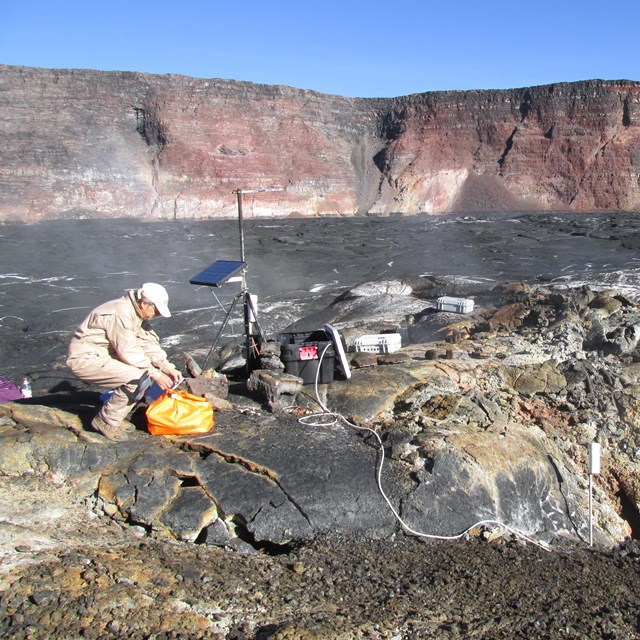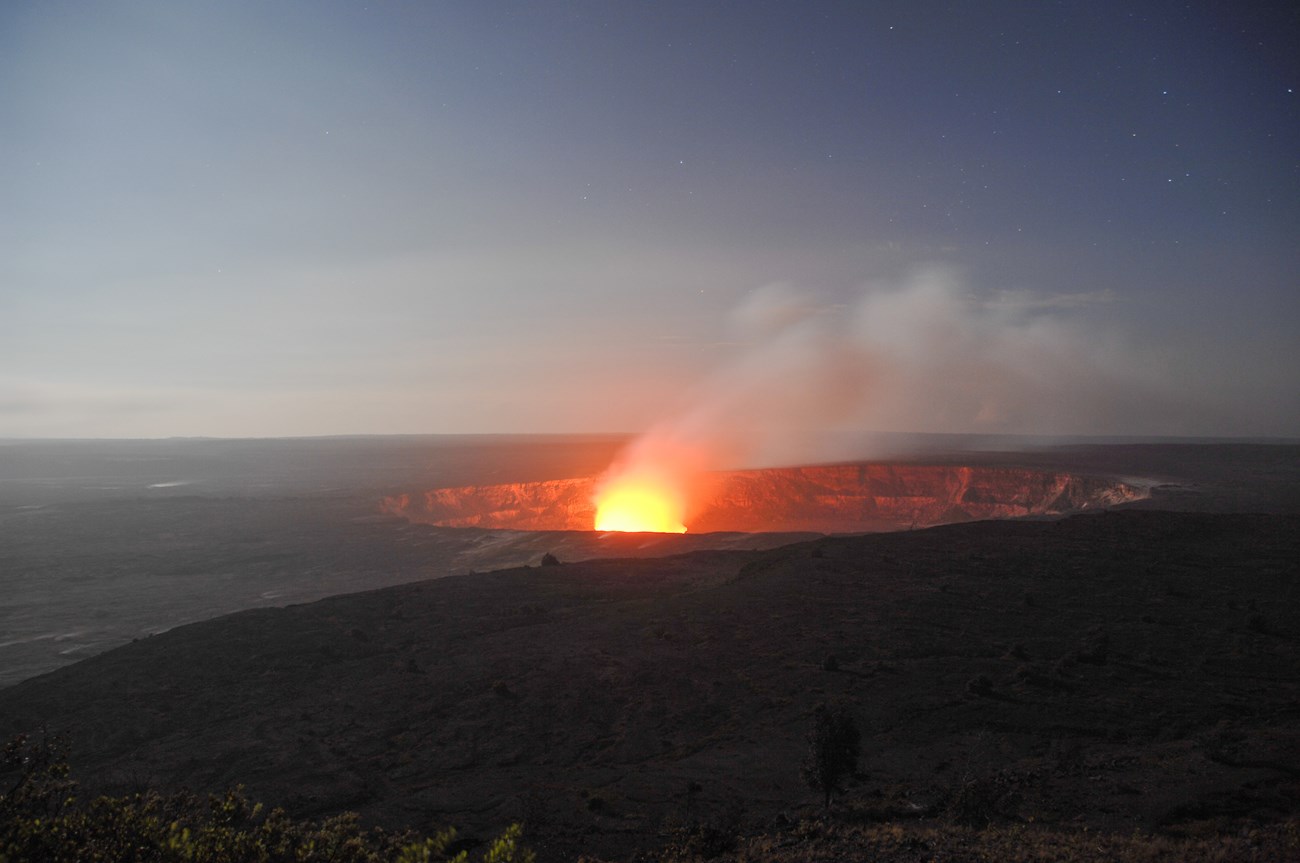
NPS photo.
Introduction
Volcanoes are both the vents where molten rock material and volcanic gases are erupted from within Earth’s interior, and the cones and mountains built up around those vents. But beyond this simple definition, volcanoes are incredibly diverse with some types being very complex.
Some volcanoes make up the largest mountains on the planet, while others are small hills that may only be a few hundred feet (meters) tall. Some volcanoes erupt multiple times over periods of hundreds of thousands of years, while others experience a single eruptive episode.
Vents, the openings at the surface where volcanic eruptions occur, and conduits, the channelways that lead from the magma reservoir to the vent, are the only features that all volcanoes have. Some types of volcanoes are exclusively made up of deposits of volcanic ash and other types of tephra. Others are nearly wholly made of lava flows. And yet others contain both pyroclastic deposits and lava flows, and possibly also lava domes, lahar, and/or landslide deposits.
Depending on how they are grouped or subdivided, there are eight different types of volcanoes based on their size, shape, eruption style and classification, and types (composition) of magma erupted. Three types of volcanoes—cinder cones, composite volcanoes, and shield volcanoes—are the most common and are the best known. But examples of all eight types of volcanoes are found in national parks.
This page explores the anatomy (the internal and external structure) of cinder cones, compositive volcanoes, and shield volcanoes, and provides short introductions to the other five types of volcanoes.
Glossary—All Volcanoes
- Conduit - The channelway or passage, which may be pipe-shaped, that brings magma from the reservoir or chamber to the vent at the surface where it is erupted.
- Magma - Molten rock beneath Earth’s surface capable of intrusion and extrusion.
- Vent - The opening or place at Earth’s surface through which magma, rock fragments, and/or volcanic gases are emitted.
- Volcanic edifice - A mountain or cone that is the main portion of a volcano. It results from the accumulation of lava, tephra, pyroclastic flows, lahars, and/or other volcanic deposits around a vent or series of vents.
- Volcano - A vent where molten rock material emerges from the Earth’s interior, and/or the edifice (mountain or cone) built up around that vent or vents during eruption(s).
Cinder Cone Volcanoes
Cinder cones are small volcanoes that consist of volcanic ash, cinders, and other types of tephra that has piled up around a vent. Cinder cones are typically built in a single eruptive period that lasts a few months and that may include the eruption of fluid lava flows from vents located along the base. Cinder cones are usually less than 1,000 feet tall (330 m).
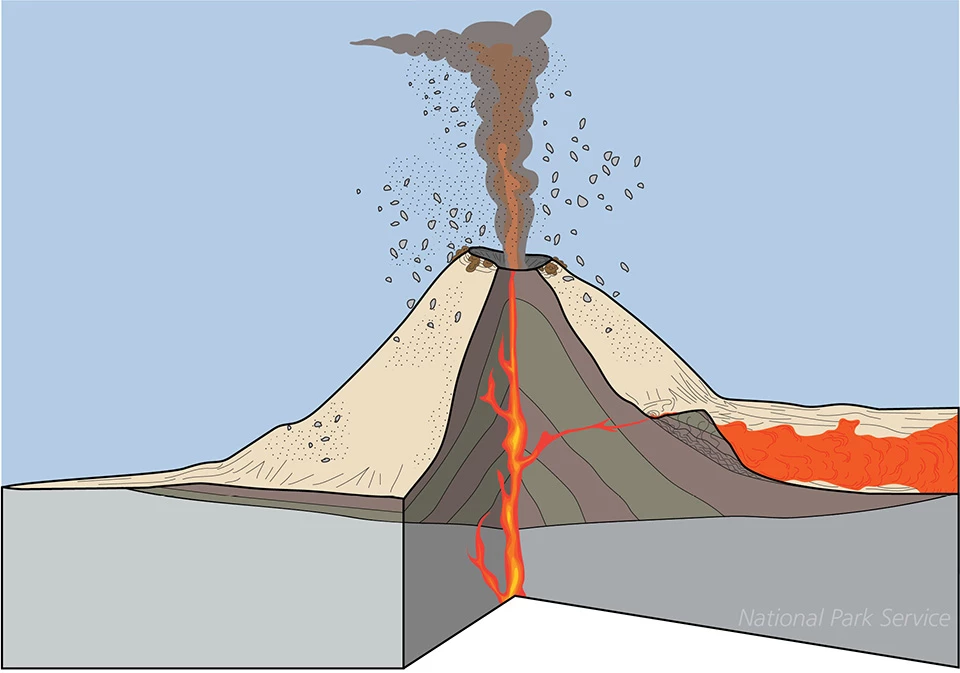
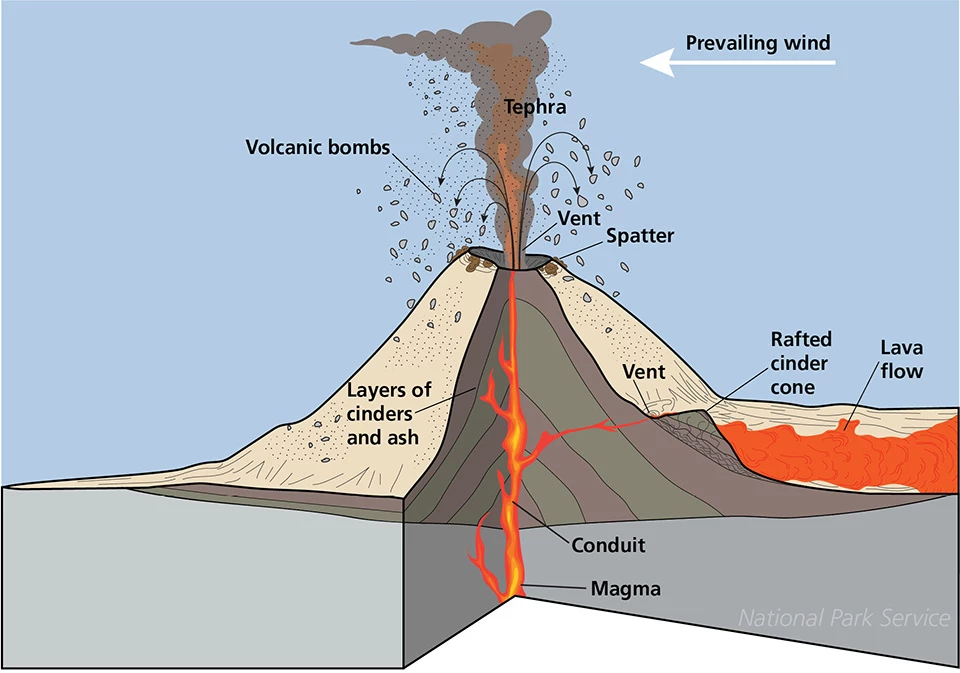
Left image
Schematic diagram of a composite volcano.
Credit: NPS illustration by Trista Thornberry-Ehrlich (Colorado State University).
Right image
Diagram with feature labels.
Credit: NPS illustration by Trista Thornberry-Ehrlich (Colorado State University).
Glossary—Cinder Cone Volcanoes
-
Ash - Fine fragments (less than 2–4 mm in diameter) of volcanic rock formed by a volcanic explosion or ejected from a volcanic vent.
-
Cinder - A colloquial term for a small nut-size to fist-size, or larger, piece of red or black highly vesicular lava that cooled in air during flight after eruption from a vent. The term is roughly synonymous with scoria.
-
Conduit - The channelway or passage, which may be pipe-shaped, that brings magma from a reservoir or chamber to the vent at the surface where it is erupted.
-
Lava flow - An outpouring of molten rock from a vent onto Earth's surface during an effusive volcanic eruption; also the resulting solidified body of rock.
-
Magma - Molten rock beneath Earth’s surface capable of intrusion and extrusion
-
Rafted cinder cone - A hill made up of cinders that is a fragment of a cinder cone that was carried away by a lava flow erupted from a side vent near the base of the cone.
-
Spatter - An accumulation of highly molten bombs that landed while still molten and welded together to form solid rock, spatter cones, or sometimes feed lava flows. Spatter is formed from fire fountains. Spatter deposits are typically only formed near a vent.
-
Tephra - A collective term used for all pyroclastic material, regardless of size, shape, or origin, ejected into the air during a volcanic eruption.
-
Vent - The opening or place at Earth’s surface through which magma, rock fragments, and/or volcanic gases are emitted.
-
Volcanic bomb - A pyroclast with a diameter greater than 64 mm (2.5 inches) with a rounded or ellipsoidal shape that indicates that it was wholly or partially molten during eruption and flight.
Cinder cones are the most common type of volcano in the National Park System. At least 24 units in the National Park System contain cinder cones.
Learn More
Composite Volcanoes
Composite volcanoes experience many eruptive periods over a long expanse of time (hundreds of thousands of years). These complex volcanoes are made of lava flows, pyroclastic deposits, as well as volcanic domes. Lahars and landslides that reshape these volcanoes may occur during eruptions or at other times. This volcano type is also known as a stratovolcano, but the term "composite volcano" is generally preferred.
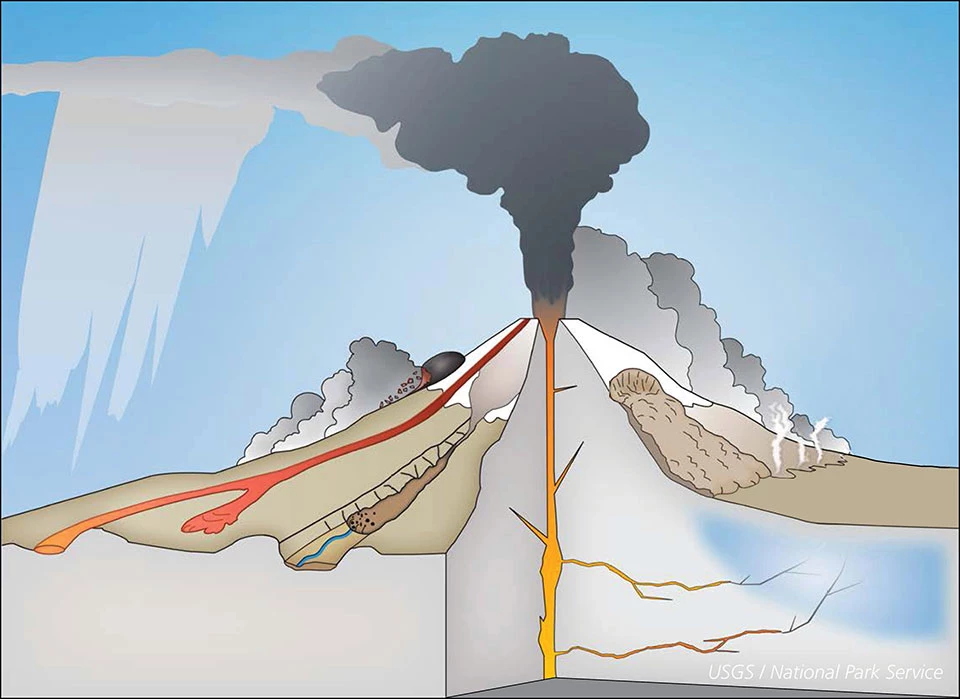
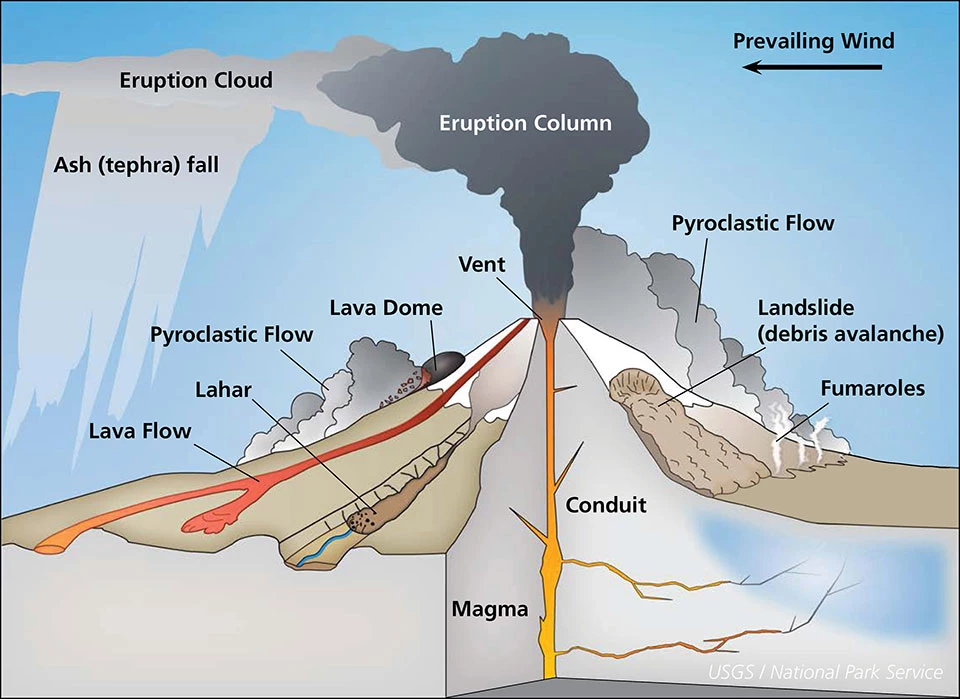
Left image
Schematic diagram of a composite volcano.
Credit: Modified from USGS illustration.
Right image
Diagram with feature labels.
Credit: Modified from USGS illustration.
Glossary—Composite Volcanoes
-
Ash - Fine fragments (less than 2–4 mm in diameter) of volcanic rock formed by a volcanic explosion or ejected from a volcanic vent.
-
Conduit - The channel or pipe that carries magma from a reservoir or chamber to the vent where it is erupted.
-
Eruption cloud - A cloud of volcanic ash, tephra, and gases that forms downwind of an erupting volcano.
-
Eruption column - A vertical pillar of superheated volcanic ash, tephra, and gases ejected from a volcanic vent during an explosive eruption. Eruption columns usually spread laterally into eruption clouds higher in the atmosphere.
-
Fumarole - A vent or opening at the surface where volcanic gases and vapors are emitted.
-
Landslide - A collective term covering a wide variety of slope-movement landforms and processes that involve the downslope transport of soil and rock material en masse under the influence of gravity. On volcanoes, landslides may occur during or soon after volcanic eruptions or at other times.
-
Lava dome - A steep-sided mass of viscous, commonly blocky, lava extruded from a vent; typically has a rounded top and covers a roughly circular area; may be isolated or associated with lobes or flows of lava from the same vent; typically silicic (rhyolite or dacite) in composition.
-
Lava flow - An outpouring of molten rock from a vent onto Earth's surface during an effusive volcanic eruption; also the resulting solidified body of rock.
-
Magma - Molten rock beneath Earth’s surface capable of intrusion and extrusion.
-
Pyroclastic flow - Pyroclastic flows are hot density currents of pumice, ash, blocks, and volcanic gas that rapidly move down the slopes of a volcano. They may be initiated by collapse of eruptive columns, by explosive eruptions that boil over, and by the collapse of lava domes.
- Tephra - A collective term used for all pyroclastic material, regardless of size, shape, or origin, ejected into the air during a volcanic eruption.
- Vent - The opening or place at Earth’s surface through which magma, rock fragments, and/or volcanic gases are emitted.
At least eight units of the National Park System contain composite volcanoes.
Learn More
Shield Volcanoes
Shield volcanoes are almost exclusively made up of fluid lava flows that can travel great distances from their vents. Shields are massive volcanoes with gentle slopes. Eruptions are usually effusive and may occur at the summit area and along fissures located along their flanks. These volcanoes are characterized by numerous lava flows, lava flow fields, as well as surface features of basaltic lava flows. Shield volcanoes experience many eruptions over their lifespans.
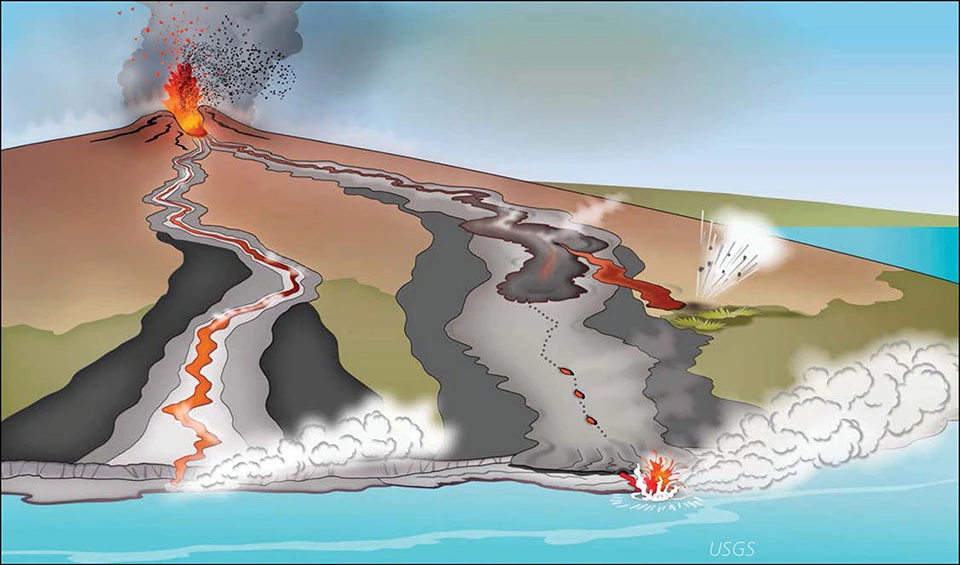
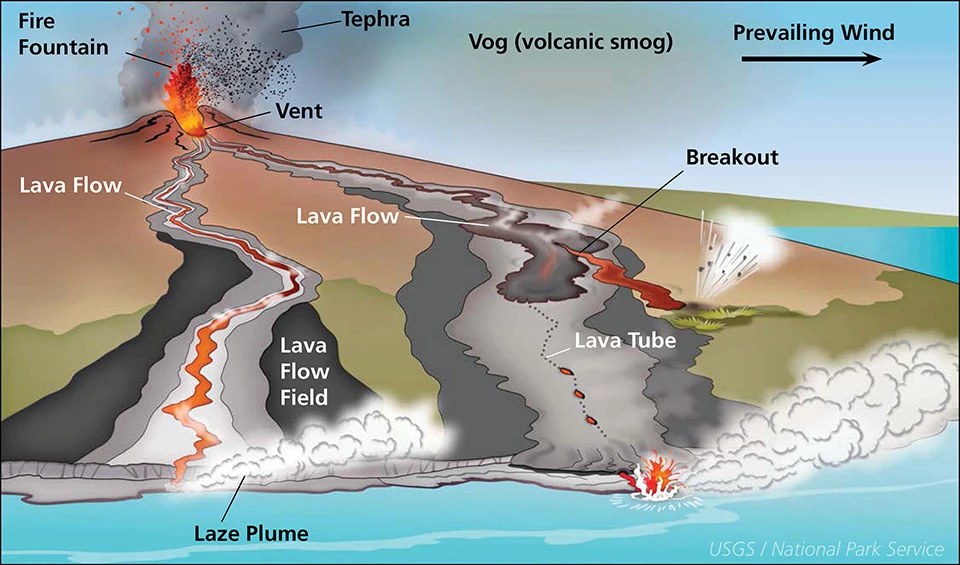
Left image
Schematic diagram of a shield volcano.
Credit: USGS illustration.
Right image
Diagram with feature labels.
Credit: USGS illustration.
Glossary—Shield Volcanoes
-
Breakout - A new area or region of a lava flow formed where lava from the molten interior of a previously-formed lobe breaks out through its sides or upper margin to create a distinct lava flow advance.
-
Fire fountain - A spray of molten lava propelled a few tens to hundreds of feet (meters) into the air by rapid expansion of gas bubbles. They may erupt from vents or form in an active lava lake. Fire fountains most commonly occur in basaltic lavas erupted in Effusive (Hawaiian) eruptions. Also called a lava fountain.
-
Lava flow - An outpouring of molten rock from a vent onto Earth's surface during an effusive volcanic eruption; also the resulting solidified body of rock.
-
Lava flow field - A body of lava, consisting of one or more lava flows, that is the product of a single eruption.
-
Laze plume - A white cloud of a mixture of condensed seawater steam, hydrochloric acid gas, and shards of volcanic glass produced when lava boils seawater to dryness. Short for “lava haze.”
-
Lava tube - Conduit through which lava travels beneath the surface of a lava flow; also, a cavernous segment of the conduit that remains after the flow of lava ceases.
-
Tephra - A collective term used for all pyroclastic material, regardless of size, shape, or origin, ejected into the air during a volcanic eruption.
-
Vent - The opening or place at Earth’s surface through which magma, rock fragments, and/or volcanic gases are emitted.
-
Vog (volcanic smog) - A hazy mixture of sulfur dioxide (SO2) gas and aerosols of sulfuric acid and other sulfates created when volcanic gases interact with oxygen and moisture in the atmosphere and sunlight. Short for “volcanic smog.”
At least 13 units in the National Park System contain shield volcanoes.
Learn More
Volcanoes of Many Sizes
Volcanoes may be of any size. At the two ends of the size spectrum, cinder cones are typically the size of small hillocks and shield volcanoes may be the most massive mountains on Earth.
The difference in size between these two types of volcanoes is so vast that it is difficult to show their relative sizes in a single illustration. Shield volcanoes may be 30 or more times taller than cinder cones, and may have a volume of 25,000 times that of a cinder cone.
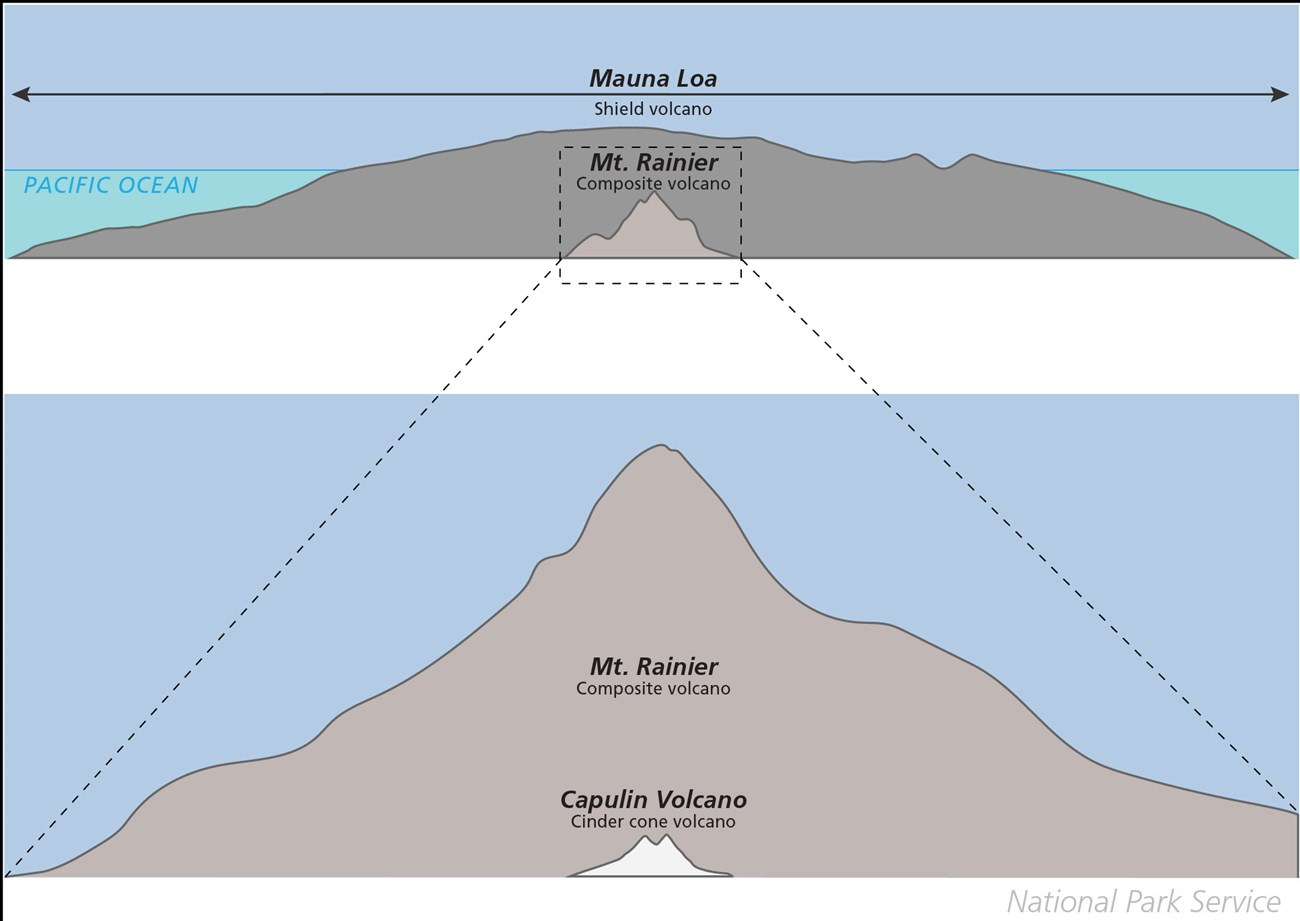
NPS illustration by Trista Thornberry-Ehrlich (Colorado State University).
Comparing The Three Classic Types of Volcanoes
|
Type |
Size |
Lifespan |
|
Cinder Cone |
Small |
Short (single eruption of a few months) |
|
Composite Volcano |
Large |
Long (hundreds of thousands of years) |
|
Shield Volcano |
Very large |
Very long |
Other Types of Volcanoes
These volcanoes frequently do not have the classical cone or shield shapes that many people ascribe to volcanic landforms. They include large features that may not at first appear to be a volcano, depressions that may be filled by lakes, and elongated vents where eruptions occur but where volcanic mountains are not constructed. Together, these types are an important part of the diversity of volcanoes. They also share many of the features of the three main types of volcanoes described above.
► Calderas
Calderas are large, roughly circular collapse features that form during voluminous eruptions that partially empty underlying magma chambers. Explosive calderas form during Volcanic Explosivity Index (VEI) 6–8 (Colossal to Apocalyptic) eruptions. Summit calderas form during climatic eruptions of preexisting composite volcanoes and may be more than 10 miles (16 km) in diameter. Resurgent calderas are even larger, with diameters of many tens of miles (kms).
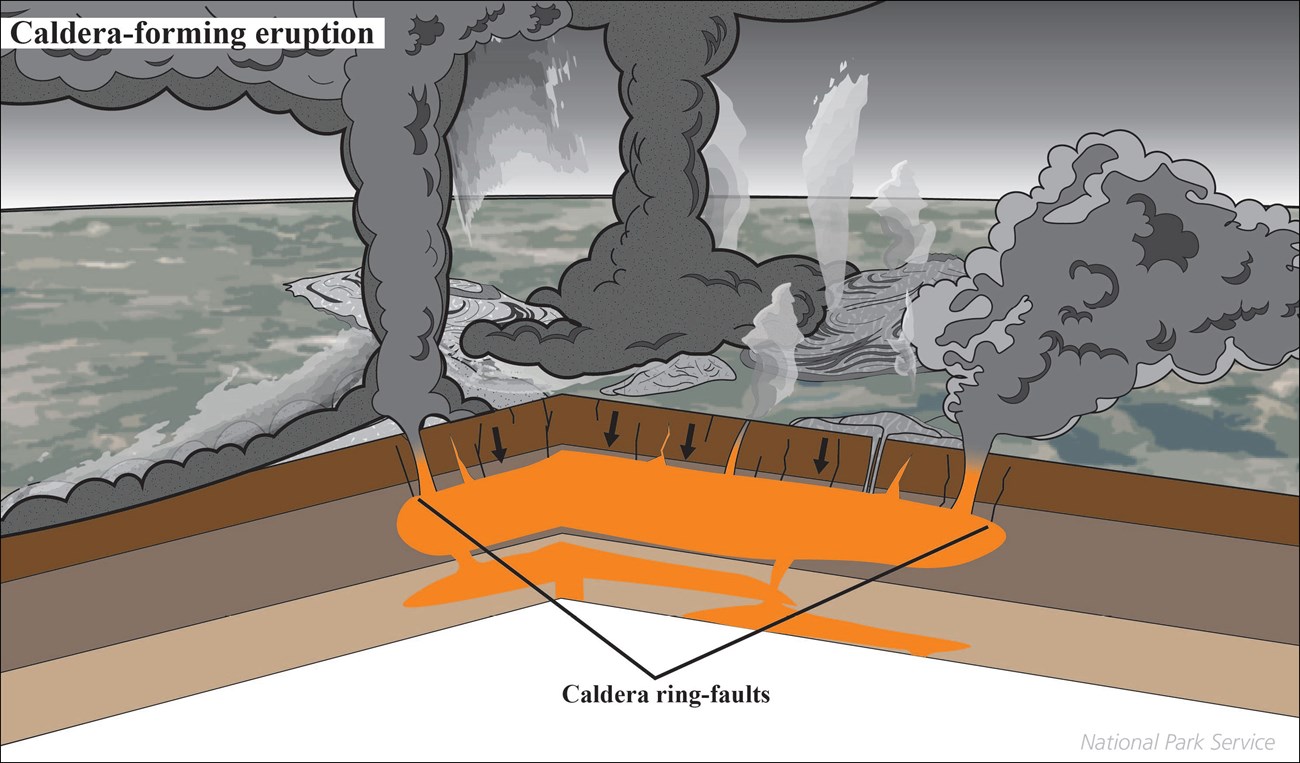
USGS public domain image.
At least eight units of the National Park System contain calderas.
Learn More
► Volcanic Domes (Lava Domes)
Volcanic domes are steep-sided accumulations of highly viscous lavas that dome up after eruption from a vent instead of flowing laterally to form a lava flow.
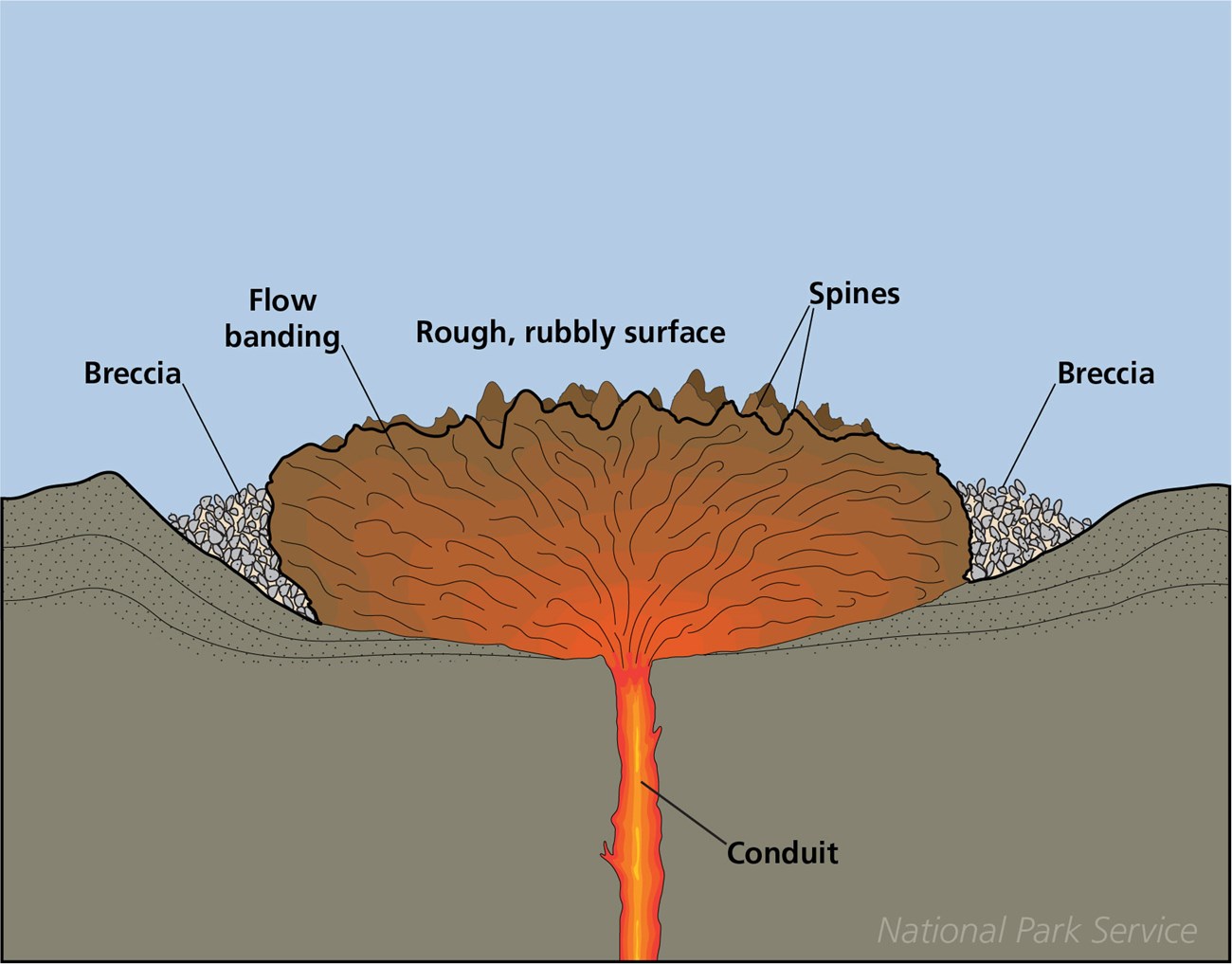
NPS illustration by Trista Thornberry-Ehrlich (Colorado State University).
At least 12 units of the National Park System contain volcanic domes.
Learn More
► Fissure Volcanoes
Volcanoes that have an elongated fissure as their vent. Some fissure volcanoes lack substantial edifices as they may erupt fluid lava flows that may travel great distances from the vent.

Graphic by Trista Thornberry-Ehrlich (Colorado State University) after Hughes and others (1999) -- Mafic Volcanism and Environmental Geology of the Eastern Snake River Plain.
At least four units of the National Park System contain fissure volcanoes.
Learn More
► Maars and tuff rings
Maars and tuff rings form during highly explosive eruptions when hot magma interacts with water. Both types of volcanoes consist of low rings of tephra surrounding a central crater. Maars have craters below the general surface elevation and result from the interaction of magma with shallow groundwater or permafrost. Tuff rings have craters above the surrounding ground surface and form when eruptions encounter surface water or ice.
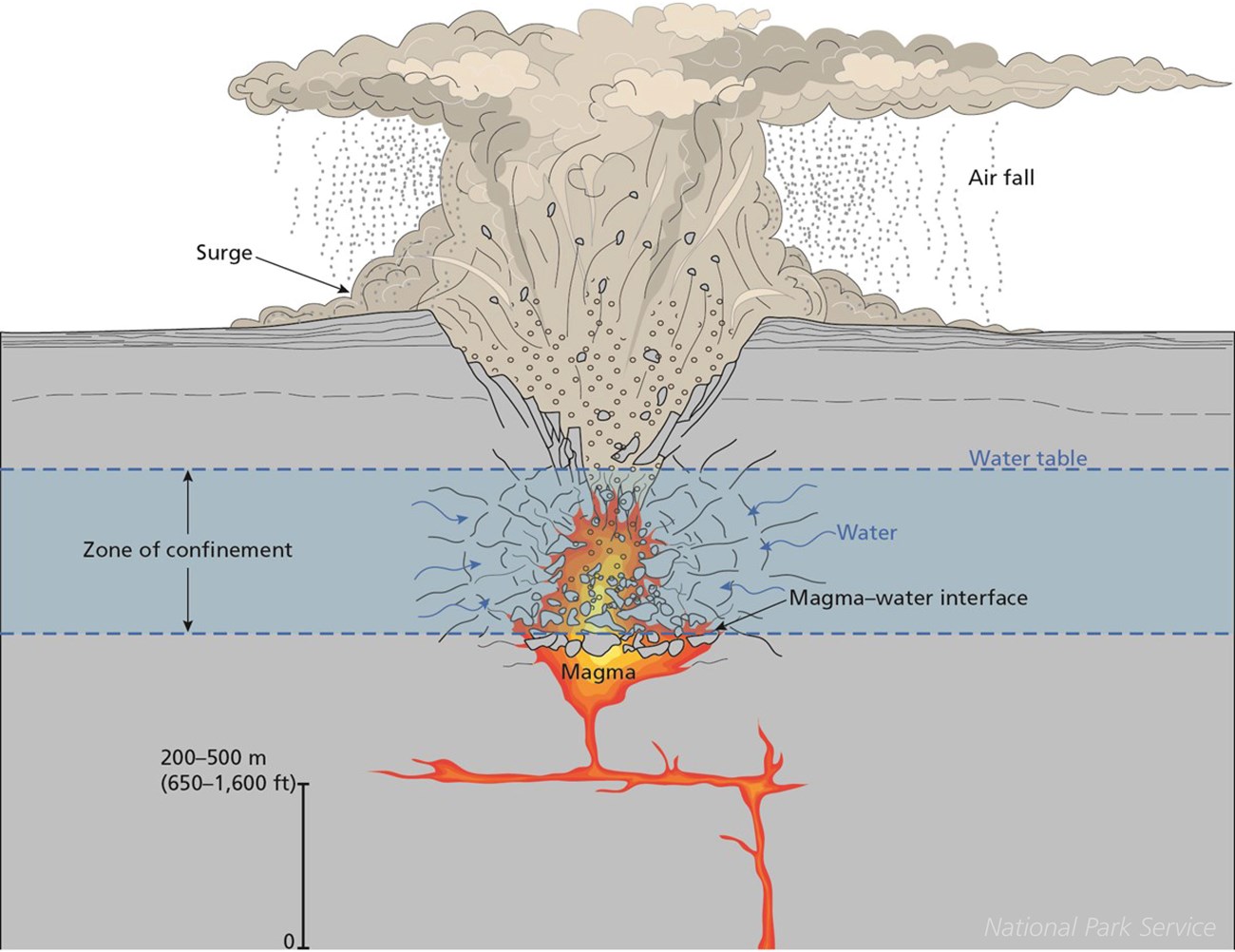
NPS illustration by Trista L. Thornberry-Ehrlich (Colorado State University).
At least six units of the National Park System contain maars or tuff rings.
Learn More
► Monogenetic Volcanic Fields
Monogenetic volcanic fields may consist of hundreds of volcanic vents and associated lava flows and form in areas with low magma supply. Individual volcanoes in these fields, whether they are cinder cones, maars, tuff rings, fissure volcanoes or other types, each have their own volcanic plumbing system.
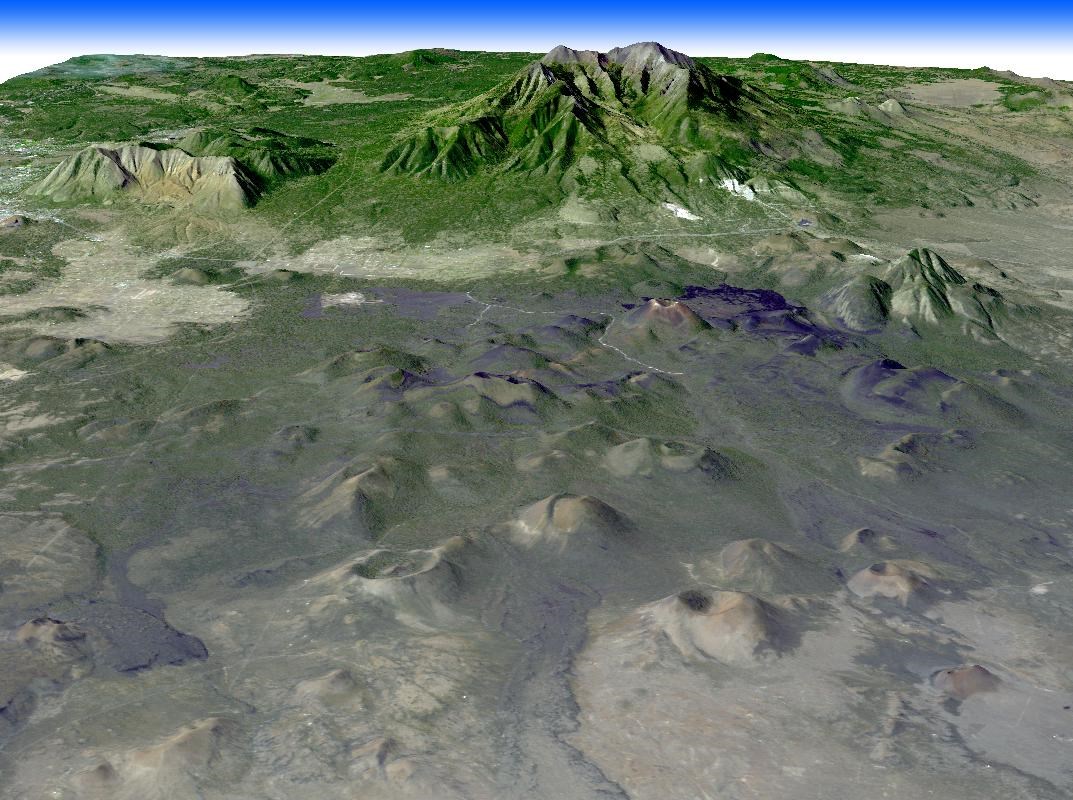
ASTER satellite image draped over USGS topographic data.
At least 13 units of the National Park system contain all or parts of monogenetic volcanic fields.
Learn More
Educational Slide Set—Volcano Illustrations
Learn More
Last updated: July 5, 2023

